Laser Powder Bed Fusion and Hot Forging of 316L Stainless Steel: A Hybrid Additive Manufacturing Approach for Enhanced Performance
Abstract
1. Introduction
2. Materials and Methods
2.1. Sample Preparation
2.2. Hot Forging Process
2.3. Microstructure Characterization
2.4. Mechanical Properties Testing
3. Results
3.1. Microstructure Characterization
3.1.1. Optical Porosity Analysis
3.1.2. SEM Analysis and EBSD Grain Orientation Analysis
3.2. Mechanical Properties and Fractography
3.2.1. Microhardness
3.2.2. Tensile Properties
3.2.3. Strain Hardening Behavior
3.2.4. SEM Fractography Analysis
4. Conclusions
Author Contributions
Funding
Institutional Review Board Statement
Informed Consent Statement
Data Availability Statement
Acknowledgments
Conflicts of Interest
Disclaimer
References
- Yang, H.; Xu, Z.; Peng, L.; Lai, X.; Fu, M. Chromium gradient stainless steels with simultaneous high strength, ductility, and corrosion-resistant: In-depth study of continuous hardening mechanisms. Int. J. Plast. 2024, 181, 104082. [Google Scholar] [CrossRef]
- Zhang, X.; Xiao, Y.; Cai, Y. Effect of Ni element on microstructure and properties of cold-rolled 316 L austenitic stainless steel. Mater. Res. Express 2024, 11, 036521. [Google Scholar] [CrossRef]
- Xu, M.; Guo, H.; Wang, Y.; Hou, Y.; Dong, Z.; Zhang, L. Mechanical properties and microstructural characteristics of 316L stainless steel fabricated by laser powder bed fusion and binder jetting. J. Mater. Res. Technol. 2023, 24, 4427–4439. [Google Scholar] [CrossRef]
- D’Andrea, D. Additive manufacturing of AISI 316L stainless steel: A review. Metals 2023, 13, 1370. [Google Scholar] [CrossRef]
- Xu, Y.; Li, Y.; Chen, T.; Dong, C.; Zhang, K.; Bao, X. A short review of medical-grade stainless steel: Corrosion resistance and novel techniques. J. Mater. Res. Technol. 2024, 29, 2788–2798. [Google Scholar] [CrossRef]
- Riabov, D.; Leicht, A.; Ahlström, J.; Hryha, E. Investigation of the strengthening mechanism in 316L stainless steel produced with laser powder bed fusion. Mater. Sci. Eng. A 2021, 822, 141699. [Google Scholar] [CrossRef]
- Li, S.; Withers, P.J.; Kabra, S.; Yan, K. The behaviour and deformation mechanisms for 316L stainless steel deformed at cryogenic temperatures. Mater. Sci. Eng. A 2023, 880, 145279. [Google Scholar] [CrossRef]
- Brennan, M.C.; Keist, J.S.; Palmer, T.A. Defects in Metal Additive Manufacturing Processes; Springer: Berlin/Heidelberg, Germany, 2021. [Google Scholar]
- Jiang, J.; Hooper, P.; Li, N.; Luan, Q.; Hopper, C.; Ganapathy, M.; Lin, J. An integrated method for net-shape manufacturing components combining 3D additive manufacturing and compressive forming processes. Procedia Eng. 2017, 207, 1182–1187. [Google Scholar] [CrossRef]
- Gordon, J.V.; Narra, S.P.; Cunningham, R.W.; Liu, H.; Chen, H.; Suter, R.M.; Beuth, J.L.; Rollett, A.D. Defect structure process maps for laser powder bed fusion additive manufacturing. Addit. Manuf. 2020, 36, 101552. [Google Scholar] [CrossRef]
- Lewandowski, J.J.; Seifi, M. Metal additive manufacturing: A review of mechanical properties. Annu. Rev. Mater. Res. 2016, 46, 151–186. [Google Scholar] [CrossRef]
- Kok, Y.; Tan, X.P.; Wang, P.; Nai, M.L.S.; Loh, N.H.; Liu, E.; Tor, S.B. Anisotropy and heterogeneity of microstructure and mechanical properties in metal additive manufacturing: A critical review. Mater. Des. 2018, 139, 565–586. [Google Scholar] [CrossRef]
- Luecke, W.E.; Slotwinski, J.A. Mechanical properties of austenitic stainless steel made by additive manufacturing. J. Res. Natl. Inst. Stand. Technol. 2014, 119, 398–418. [Google Scholar] [CrossRef] [PubMed]
- Mohd Yusuf, S.; Chen, Y.; Boardman, R.; Yang, S.; Gao, N. Investigation on porosity and microhardness of 316L stainless steel fabricated by selective laser melting. Metals 2017, 7, 64. [Google Scholar] [CrossRef]
- Dzugan, J.; Seifi, M.; Rund, M.; Podany, P.; Grylls, R.; Lewandowski, J.J. The use of miniature specimens to determine local properties and fracture behavior of LPBF-processed Inconel 718 in as-deposited and post-treated states. Materials 2022, 15, 4724. [Google Scholar] [CrossRef]
- Dzugan, J.; Seifi, M.; Prochazka, R.; Rund, M.; Podany, P.; Konopik, P.; Lewandowski, J.J. Effects of thickness and orientation on the small scale fracture behaviour of additively manufactured Ti-6Al-4V. Mater. Charact. 2018, 143, 94–109. [Google Scholar] [CrossRef]
- Koch, C.C. Optimization of strength and ductility in nanocrystalline and ultrafine grained metals. Scr. Mater. 2003, 49, 657–662. [Google Scholar] [CrossRef]
- Valiev, R.Z.; Alexandrov, I.V.; Zhu, Y.T.; Lowe, T.C. Paradox of strength and ductility in metals processed bysevere plastic deformation. J. Mater. Res. 2002, 17, 5–8. [Google Scholar] [CrossRef]
- Wu, X.; Yang, M.; Yuan, F.; Wu, G.; Wei, Y.; Huang, X.; Zhu, Y. Heterogeneous lamella structure unites ultrafine-grain strength with coarse-grain ductility. Proc. Natl. Acad. Sci. USA 2015, 112, 14501–14505. [Google Scholar] [CrossRef]
- Williams, S.W.; Martina, F.; Addison, A.C.; Ding, J.; Pardal, G.; Colegrove, P. Wire + Arc Additive Manufacturing. Mater. Sci. Technol. 2016, 32, 641–647. [Google Scholar]
- Seow, C.E.; Coules, H.E.; Wu, G.; Khan, R.H.U.; Xu, X.; Williams, S. Wire+ Arc Additively Manufactured Inconel 718: Effect of post-deposition heat treatments on microstructure and tensile properties. Mater. Des. 2019, 183, 108157. [Google Scholar]
- Meiners, F.; Ihne, J.; Jürgens, P.; Hemes, S.; Mathes, M.; Sizova, I.; Bambach, M.; Hama-Saleh, R.; Weisheit, A. New hybrid manufacturing routes combining forging and additive manufacturing to efficiently produce high performance components from Ti-6Al-4V. Procedia Manuf. 2020, 47, 261–267. [Google Scholar] [CrossRef]
- Lynch, P.; Hasbrouck, C.R.; Wilck, J.; Kay, M.; Manogharan, G. Challenges and opportunities to integrate the oldest and newest manufacturing processes: Metal casting and additive manufacturing. Rapid Prototyp. J. 2020, 26, 1145–1154. [Google Scholar] [CrossRef]
- Sizova, I.; Bambach, M. Hot workability and microstructure evolution of pre-forms for forgings produced by additive manufacturing. J. Mater. Process. Technol. 2018, 256, 154–159. [Google Scholar] [CrossRef]
- Bambach, M.; Sizova, I. Hot Working Behavior of Selective Laser Melted and Laser Metal Deposited Inconel 718; AIP Publishing: New York, NY, USA, 2018. [Google Scholar]
- Haghdadi, N.; Laleh, M.; Moyle, M.; Primig, S. Additive manufacturing of steels: A review of achievements and challenges. J. Mater. Sci. 2021, 56, 64–107. [Google Scholar] [CrossRef]
- Obeidi, M.A.; Mhurchadha, S.M.U.; Raghavendra, R.; Conway, A.; Souto, C.; Tormey, D.; Ahad, I.U.; Brabazon, D. Comparison of the porosity and mechanical performance of 316L stainless steel manufactured on different laser powder bed fusion metal additive manufacturing machines. J. Mater. Res. Technol. 2021, 13, 2361–2374. [Google Scholar] [CrossRef]
- Das, S.; Bourell, D.L.; Babu, S.S. Metallic materials for 3D printing. Mrs Bull. 2016, 41, 729–741. [Google Scholar] [CrossRef]
- Hive, A. 3D metal powder plant. Alum. Int. Today 2016, 28, 6. [Google Scholar]
- Cai, X.; Malcolm, A.A.; Wong, B.S.; Fan, Z. Measurement and characterization of porosity in aluminium selective laser melting parts using X-ray CT. Virtual Phys. Prototyp. 2015, 10, 195–206. [Google Scholar] [CrossRef]
- Joshi, K.; Promoppatum, P.; Quek, S.S.; Raghavan, S.; Johan, N.S.; Shukla, S.; Samudrala, S.; van der Veen, S.; Jhon, M.H. Effect of porosity distribution on the strength and strain-to-failure of Laser-Powder Bed Fusion printed Ti–6Al–4V. Addit. Manuf. 2023, 75, 103738. [Google Scholar] [CrossRef]
- Afroz, L.; Inverarity, S.B.; Qian, M.; Easton, M.; Das, R. Analysing the effect of defects on stress concentration and fatigue life of L-PBF AlSi10Mg alloy using finite element modelling. Prog. Addit. Manuf. 2024, 9, 341–359. [Google Scholar] [CrossRef]
- Tammas-Williams, S.; Withers, P.J.; Todd, I.; Prangnell, P.B. The influence of porosity on fatigue crack initiation in additively manufactured titanium components. Sci. Rep. 2017, 7, 7308. [Google Scholar] [CrossRef]
- Zhang, W.; Liu, J.; Xing, Y.; Ao, X.; Yang, R.; Yang, C.; Tan, J. Effects of Pore Defects on Stress Concentration of Laser Melting Deposition-Manufactured AlSi10Mg via Crystal Plasticity Finite Element Method. Materials 2025, 18, 2285. [Google Scholar] [PubMed]
- Kan, W.H.; Chiu, L.N.S.; Lim, C.V.S.; Zhu, Y.; Tian, Y.; Jiang, D.; Huang, A. A critical review on the effects of process-induced porosity on the mechanical properties of alloys fabricated by laser powder bed fusion. J. Mater. Sci. 2022, 57, 9818–9865. [Google Scholar] [CrossRef]
- Montero-Sistiaga, M.L.; Godino-Martinez, M.; Boschmans, K.; Kruth, J.-P.; Van Humbeeck, J.; Vanmeensel, K. Microstructure evolution of 316L produced by HP-SLM (high power selective laser melting). Addit. Manuf. 2018, 23, 402–410. [Google Scholar] [CrossRef]
- Khodabakhshi, F.; Hasani, N.; Kalaie, M.R.; Hadadzadeh, A.; Wells, M.A.; Mohammadi, M. Dynamic recrystallization under hot deformation of additively manufactured 316 L stainless steel. Mater. Charact. 2023, 202, 113055. [Google Scholar] [CrossRef]
- Rajput, S.K.; Kumar, J.; Mehta, Y.; Soota, T.; Saxena, K.K. Microstructural evolution and mechanical properties of 316L stainless steel using multiaxial forging. Adv. Mater. Process. Technol. 2020, 6, 509–518. [Google Scholar] [CrossRef]
- Hopper, C.; Pruncu, C.I.; Hooper, P.A.; Tan, Z.; Yang, S.-T.; Liu, Y.; Jiang, J. The effects of hot forging on the preform additive manufactured 316 stainless steel parts. Micron 2021, 143, 103026. [Google Scholar] [CrossRef]
- Liu, Y.; Zhang, C.; Wang, Y.; Xu, X.; Zhu, H.; Jiang, J. Reveal the hot deformation behaviour and microstructure evolution in additively manufactured 316L stainless steel. Mater. Sci. Eng. A 2022, 861, 144290. [Google Scholar] [CrossRef]
- Dixit, S.; Liu, S.; Murdoch, H.A.; Smith, P.M. Investigating build orientation-induced mechanical anisotropy in additive manufacturing 316L stainless steel. Mater. Sci. Eng. A 2023, 880, 145308. [Google Scholar] [CrossRef]
- Shanmuganathan, P.K.; Purushothaman, D.B.; Ponnusamy, M. Effect of high laser energy density on selective laser melted 316L stainless steel: Analysis on metallurgical and mechanical properties and comparison with wrought 316L stainless steel. 3D Print. Addit. Manuf. 2023, 10, 383–392. [Google Scholar] [CrossRef]
- Pruncu, C.I.; Hopper, C.; Hooper, P.A.; Tan, Z.; Zhu, H.; Lin, J.; Jiang, J. Study of the effects of hot forging on the additively manufactured stainless steel preforms. J. Manuf. Process. 2020, 57, 668–676. [Google Scholar] [CrossRef]
- Byun, T.S.; Garrison, B.E.; McAlister, M.R.; Chen, X.; Gussev, M.N.; Lach, T.G.; Le Coq, A.; Linton, K.; Joslin, C.B.; Carver, J.K. Mechanical behavior of additively manufactured and wrought 316L stainless steels before and after neutron irradiation. J. Nucl. Mater. 2021, 548, 152849. [Google Scholar] [CrossRef]
- Taghipour, A.; Mazaheri, Y.; McDavid, J.; Sheikhi, S.; Braun, M.; Shen, J.; Klusemann, B.; Ehlers, S. Strengthening mechanisms and strain hardening behavior of 316L stainless steel manufactured by laser--based powder bed fusion. Adv. Eng. Mater. 2023, 25, 2201230. [Google Scholar] [CrossRef]
- Cooper, A.J.; Brayshaw, W.J.; Sherry, A.H. Tensile fracture behavior of 316L austenitic stainless steel manufactured by hot isostatic pressing. Metall. Mater. Trans. A 2018, 49, 1579–1591. [Google Scholar] [CrossRef]
- Yoon, K.B.; Dao, V.H.; Yu, J.M. Effects of build direction on tensile and creep properties of 316L stainless steel produced by selective laser melting. Fatigue Fract. Eng. Mater. Struct. 2020, 43, 2623–2636. [Google Scholar] [CrossRef]
- Güden, M.; Yavaş, H.; Tanrıkulu, A.A.; Taşdemirci, A.; Akın, B.; Enser, S.; Karakuş, A.; Hamat, B.A. Orientation dependent tensile properties of a selective-laser-melt 316L stainless steel. Mater. Sci. Eng. A 2021, 824, 141808. [Google Scholar] [CrossRef]
- Bowen, A.W.; Partridge, P.G. Limitations of the Hollomon strain-hardening equation. J. Phys. D Appl. Phys. 1974, 7, 969. [Google Scholar] [CrossRef]
- Li, Z.; Voisin, T.; McKeown, J.T.; Ye, J.; Braun, T.; Kamath, C.; King, W.E.; Wang, Y.M. Tensile properties, strain rate sensitivity, and activation volume of additively manufactured 316L stainless steels. Int. J. Plast. 2019, 120, 395–410. [Google Scholar] [CrossRef]
- Afkhami, S.; Dabiri, M.; Piili, H.; Björk, T. Effects of manufacturing parameters and mechanical post-processing on stainless steel 316L processed by laser powder bed fusion. Mater. Sci. Eng. A 2021, 802, 140660. [Google Scholar] [CrossRef]
- Qin, W.; Li, J.; Liu, Y.; Kang, J.; Zhu, L.; Shu, D.; Peng, P.; She, D.; Meng, D.; Li, Y. Effects of grain size on tensile property and fracture morphology of 316L stainless steel. Mater. Lett. 2019, 254, 116–119. [Google Scholar] [CrossRef]
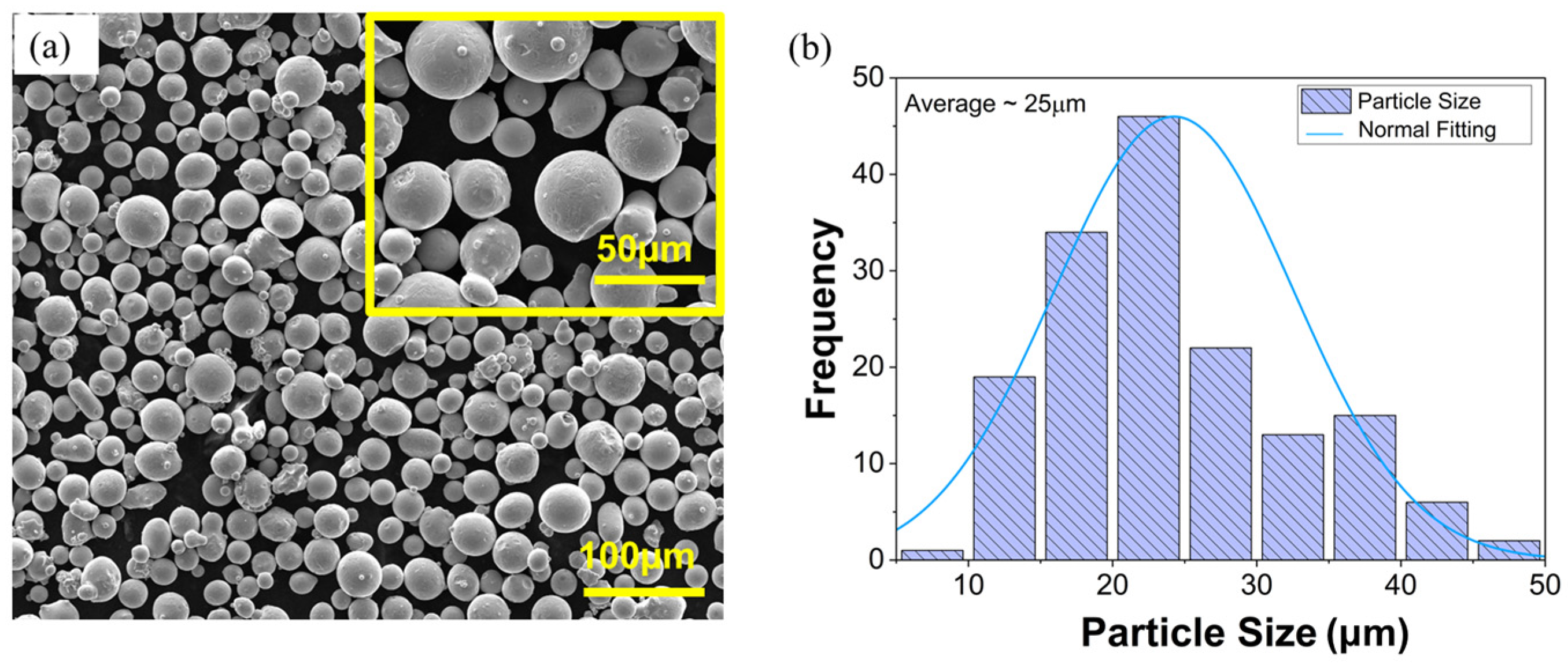
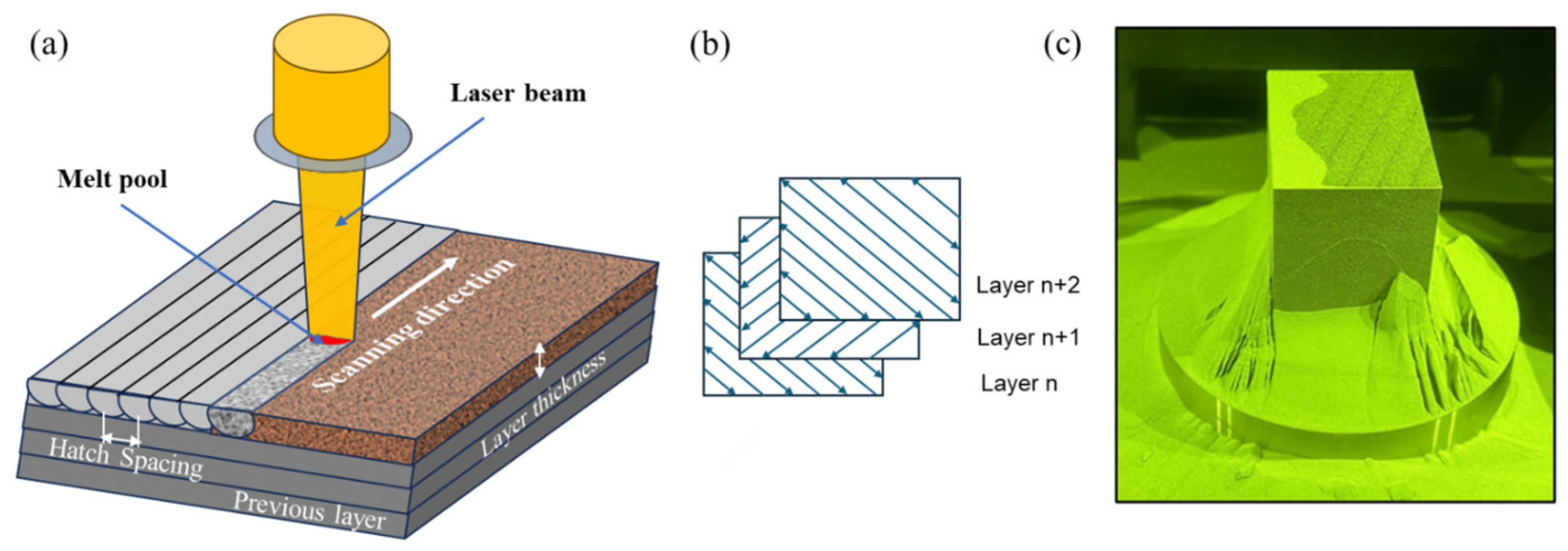
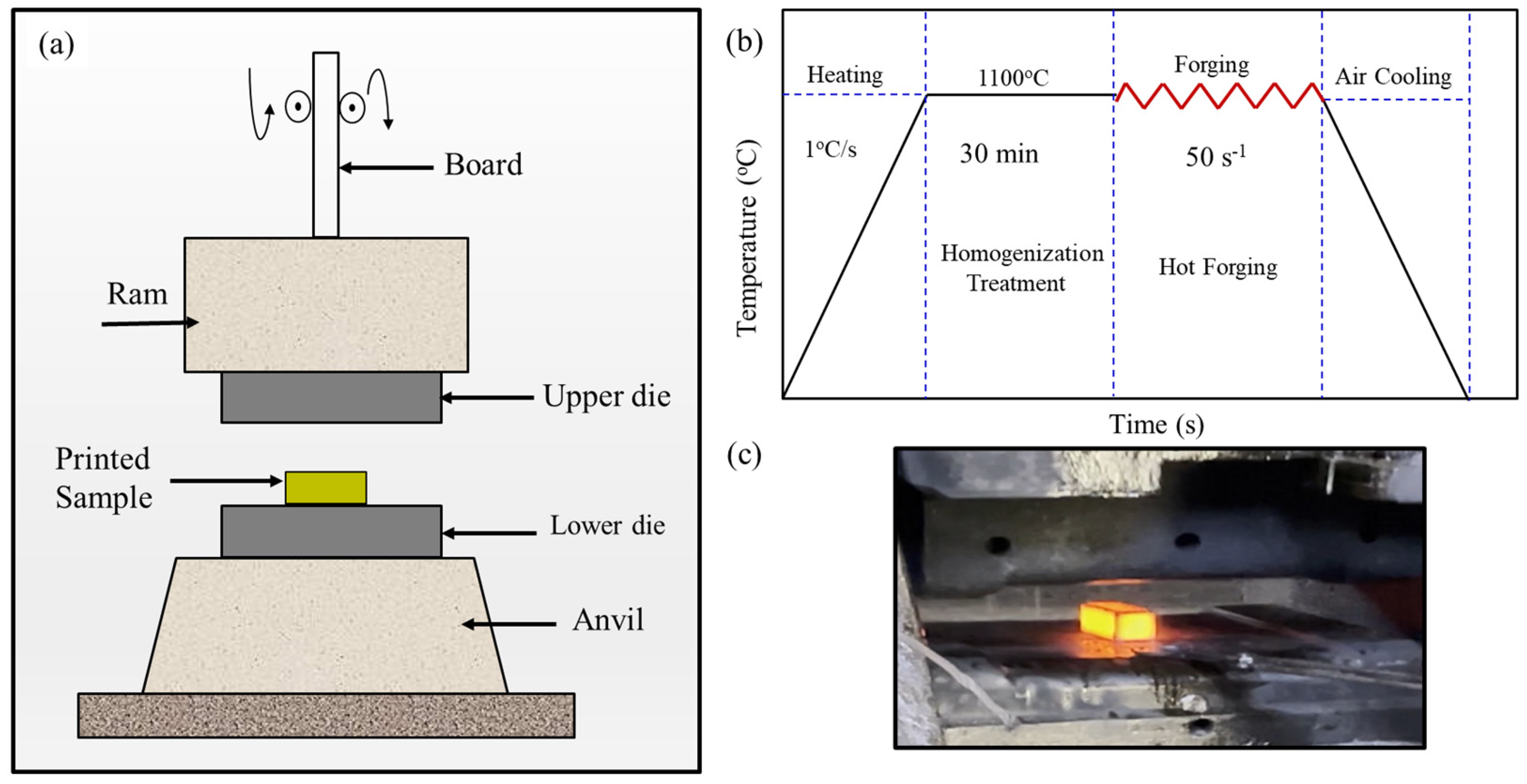
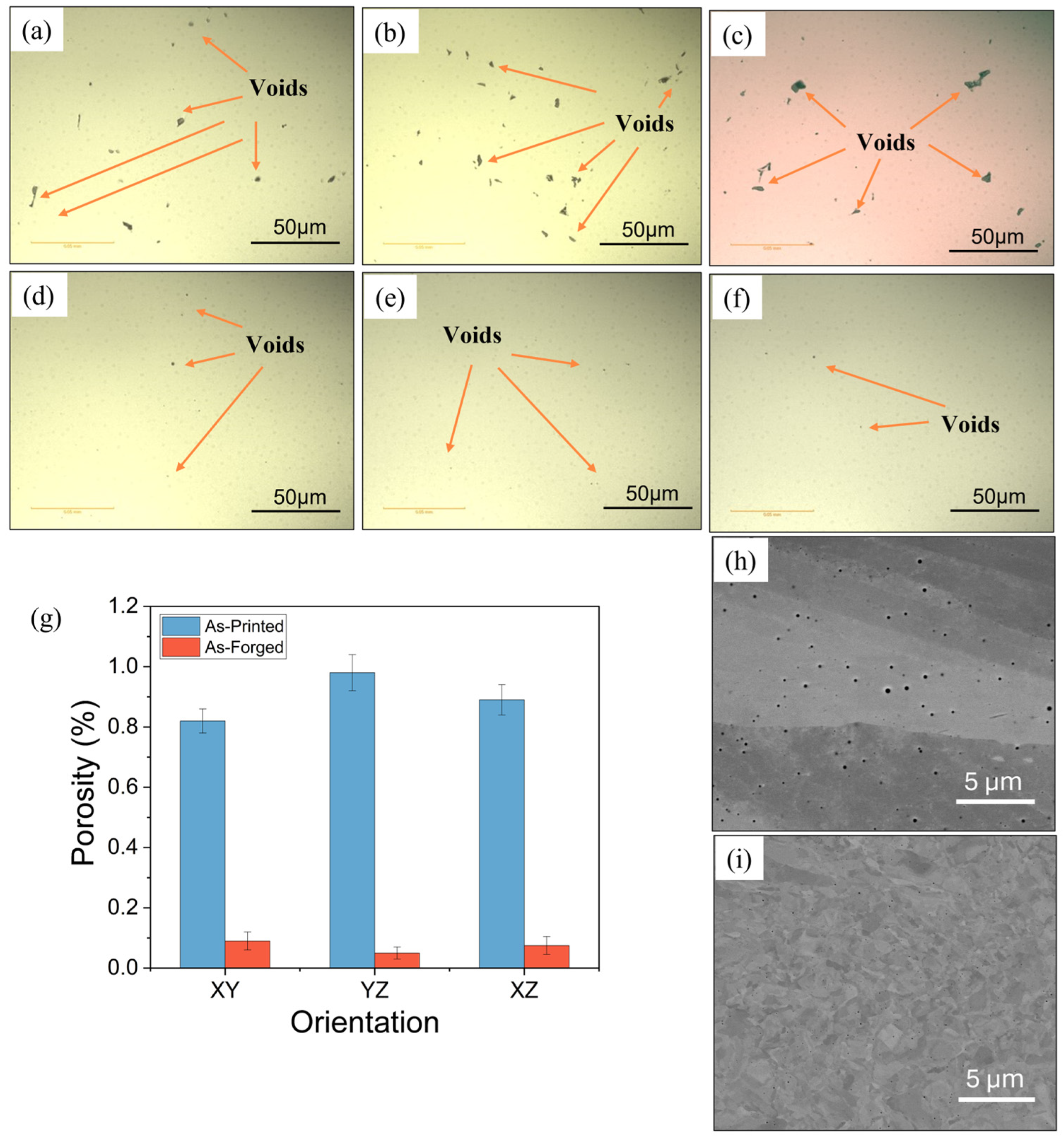
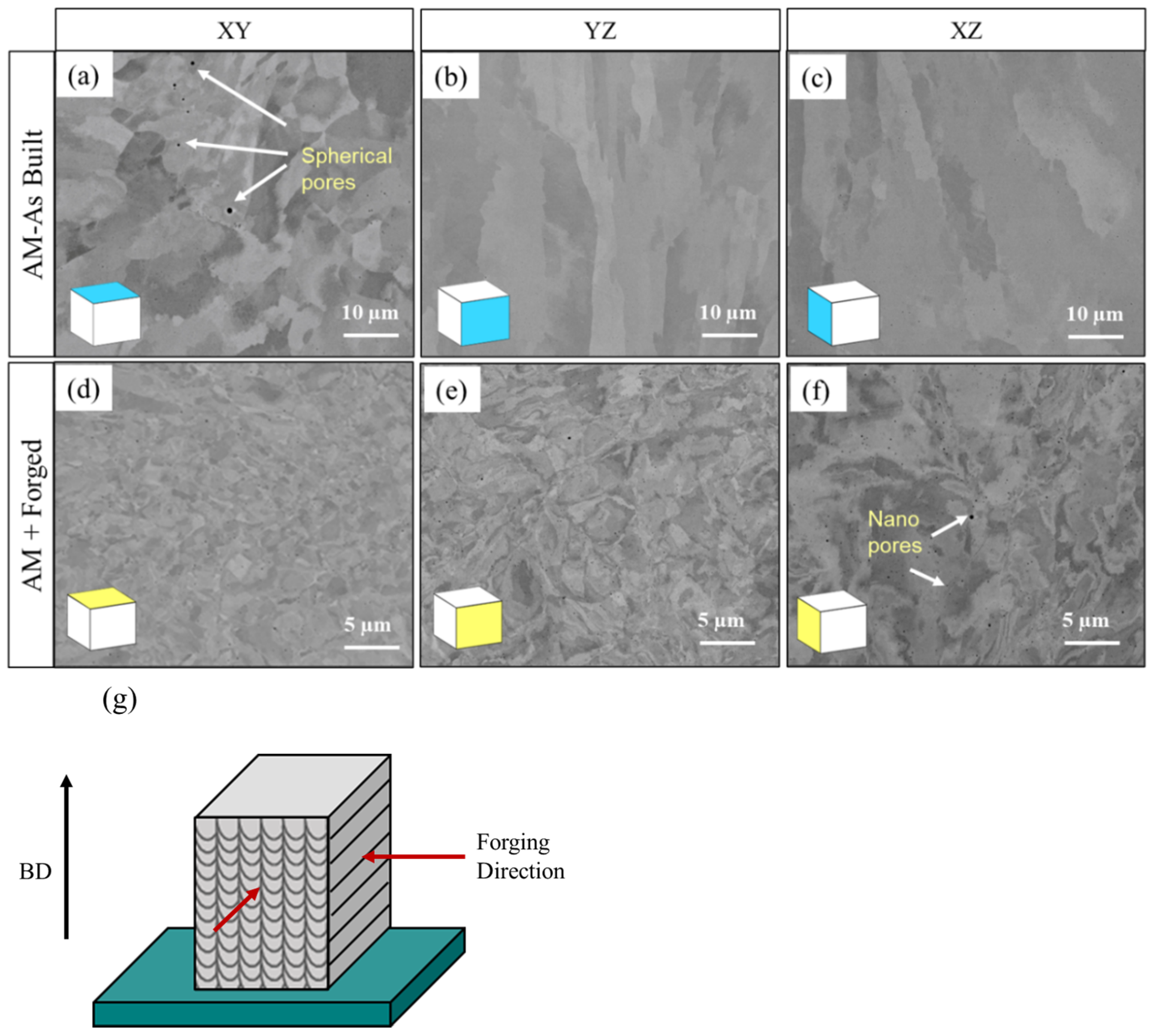
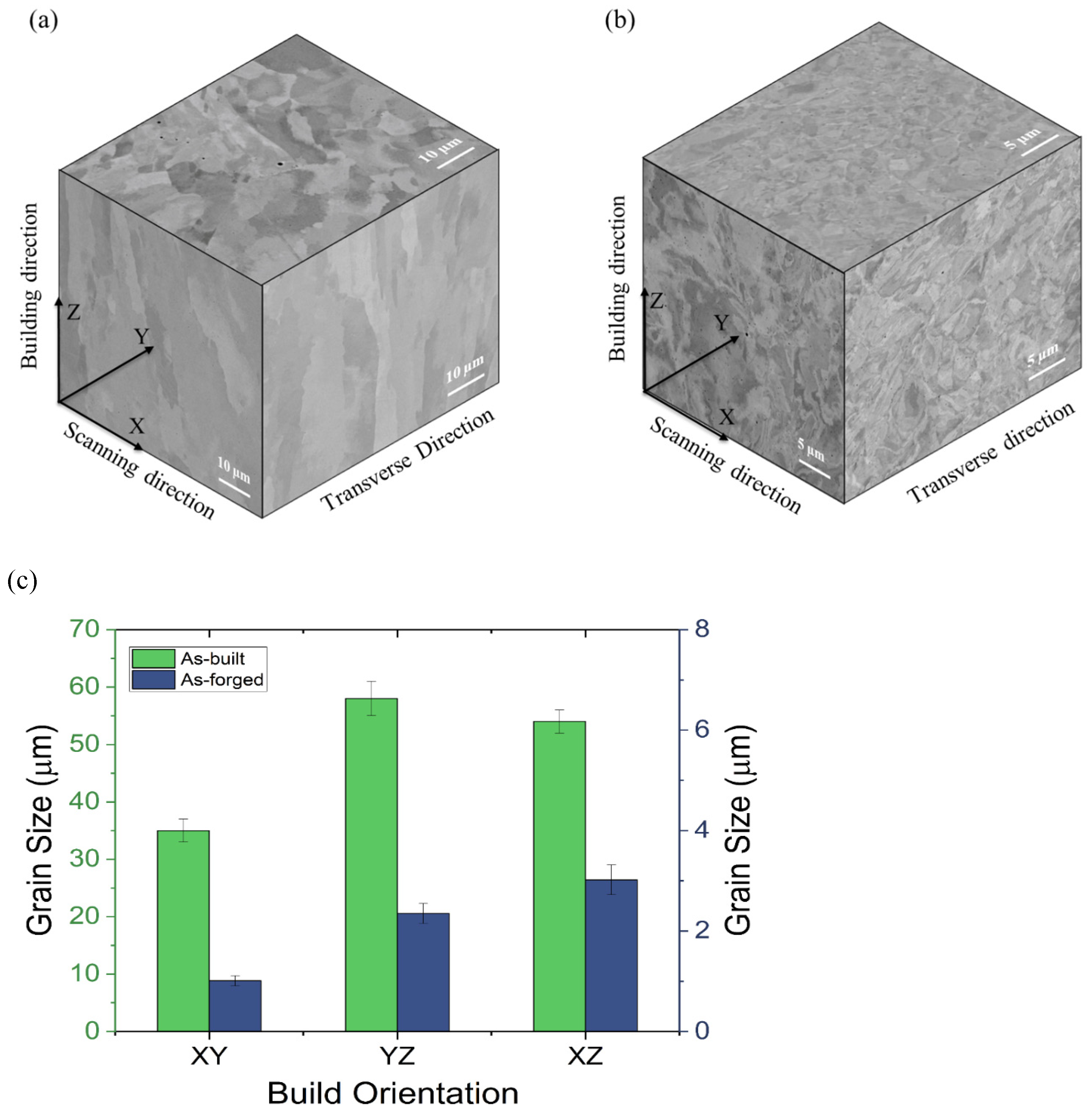

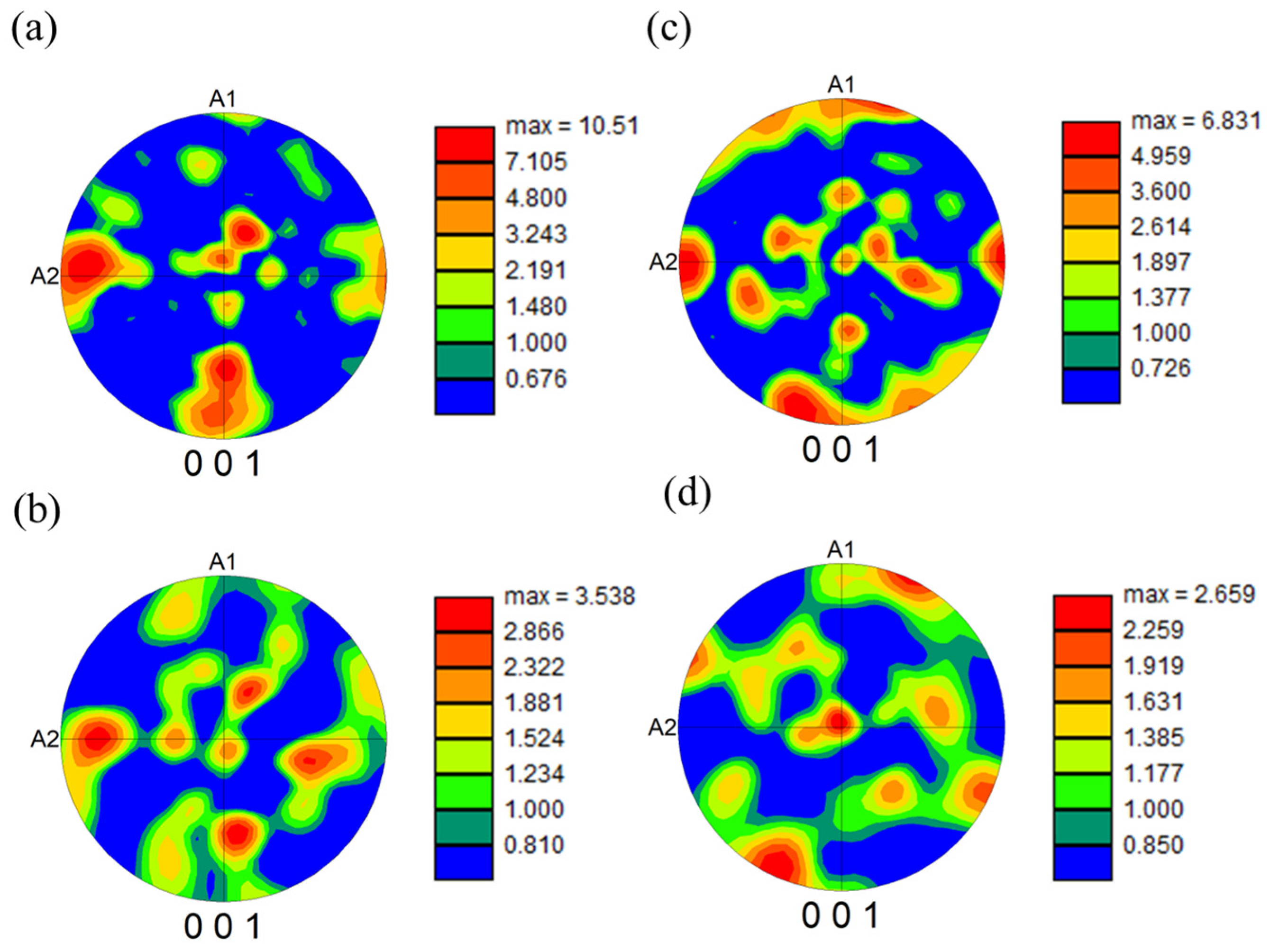

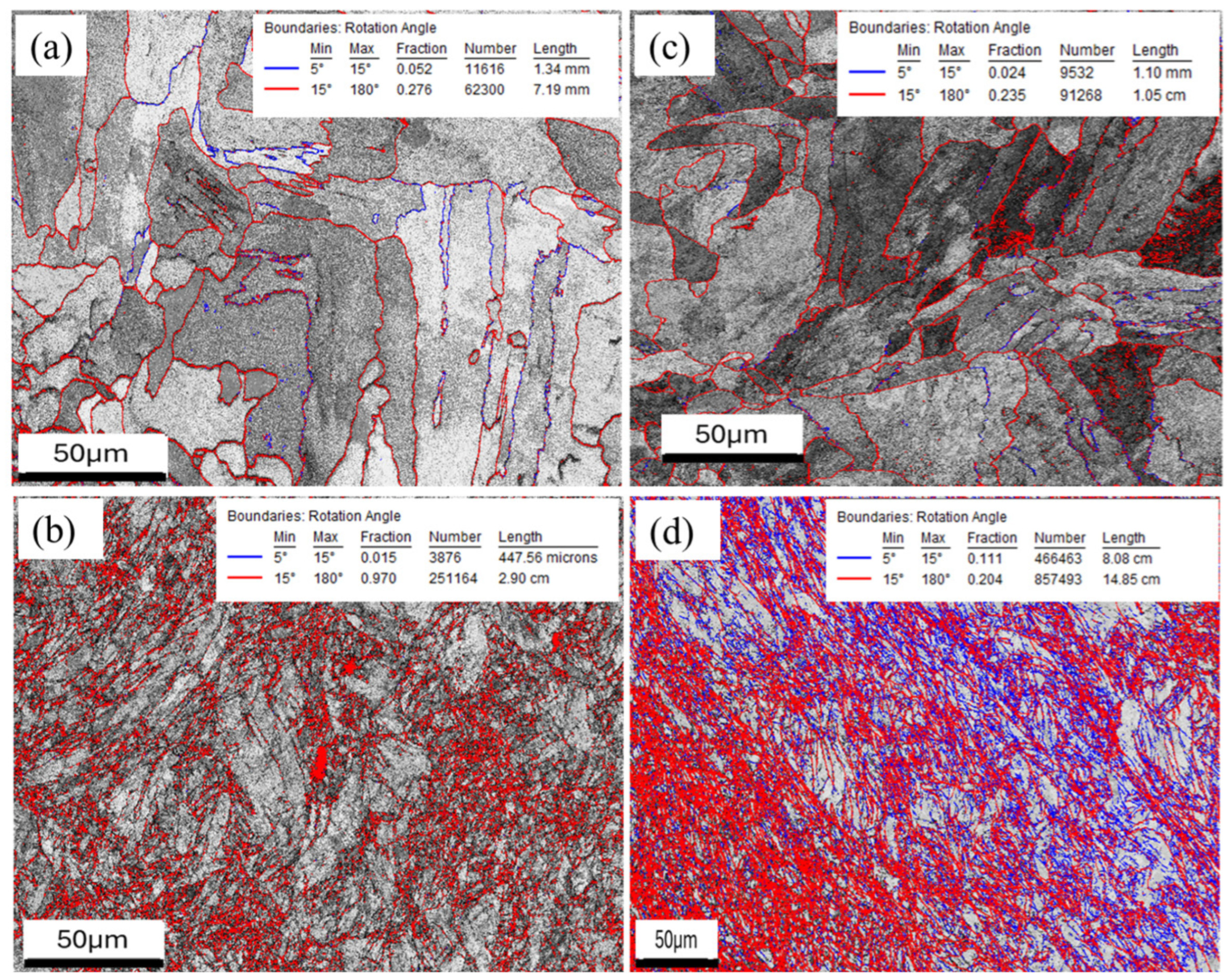

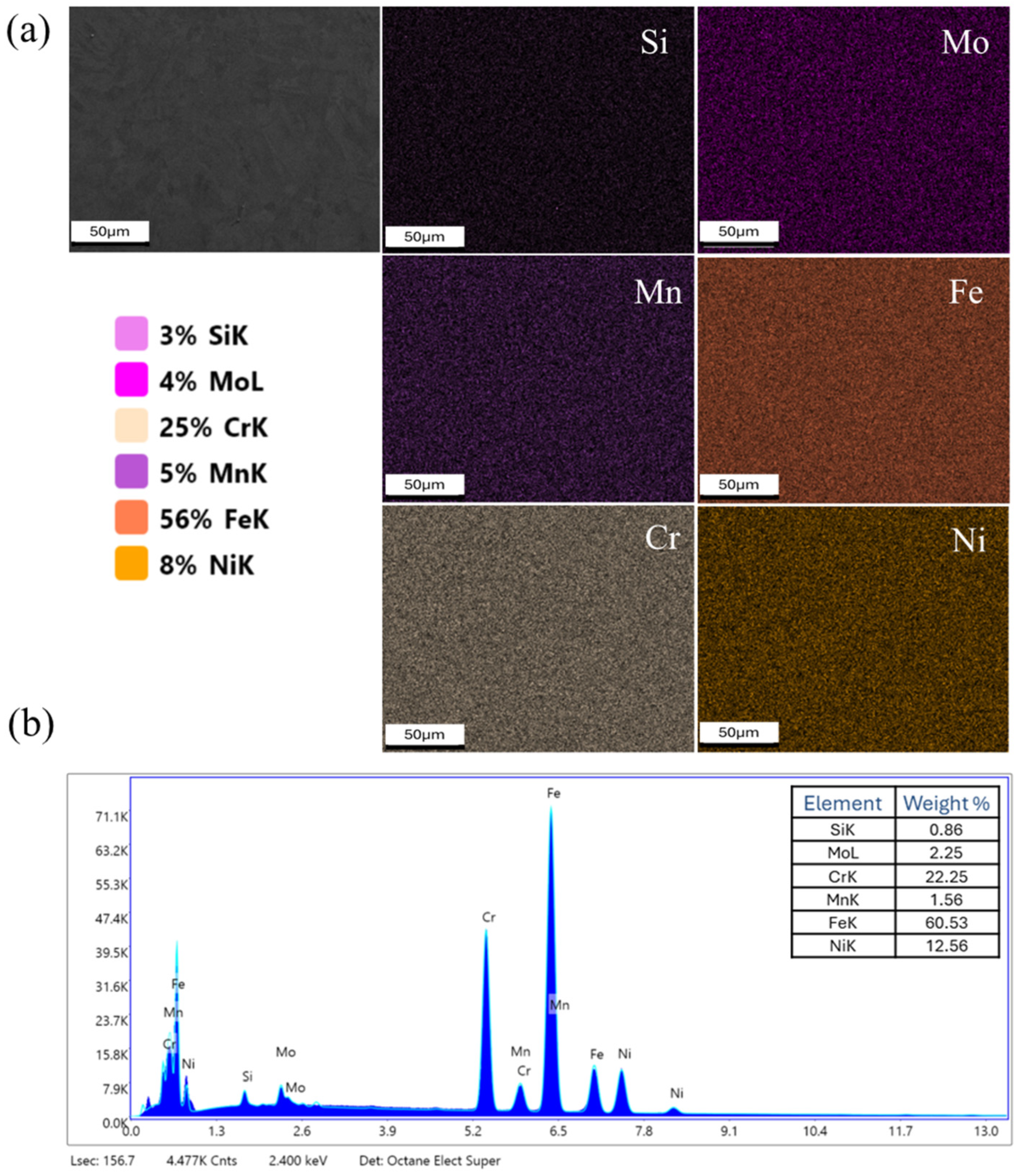

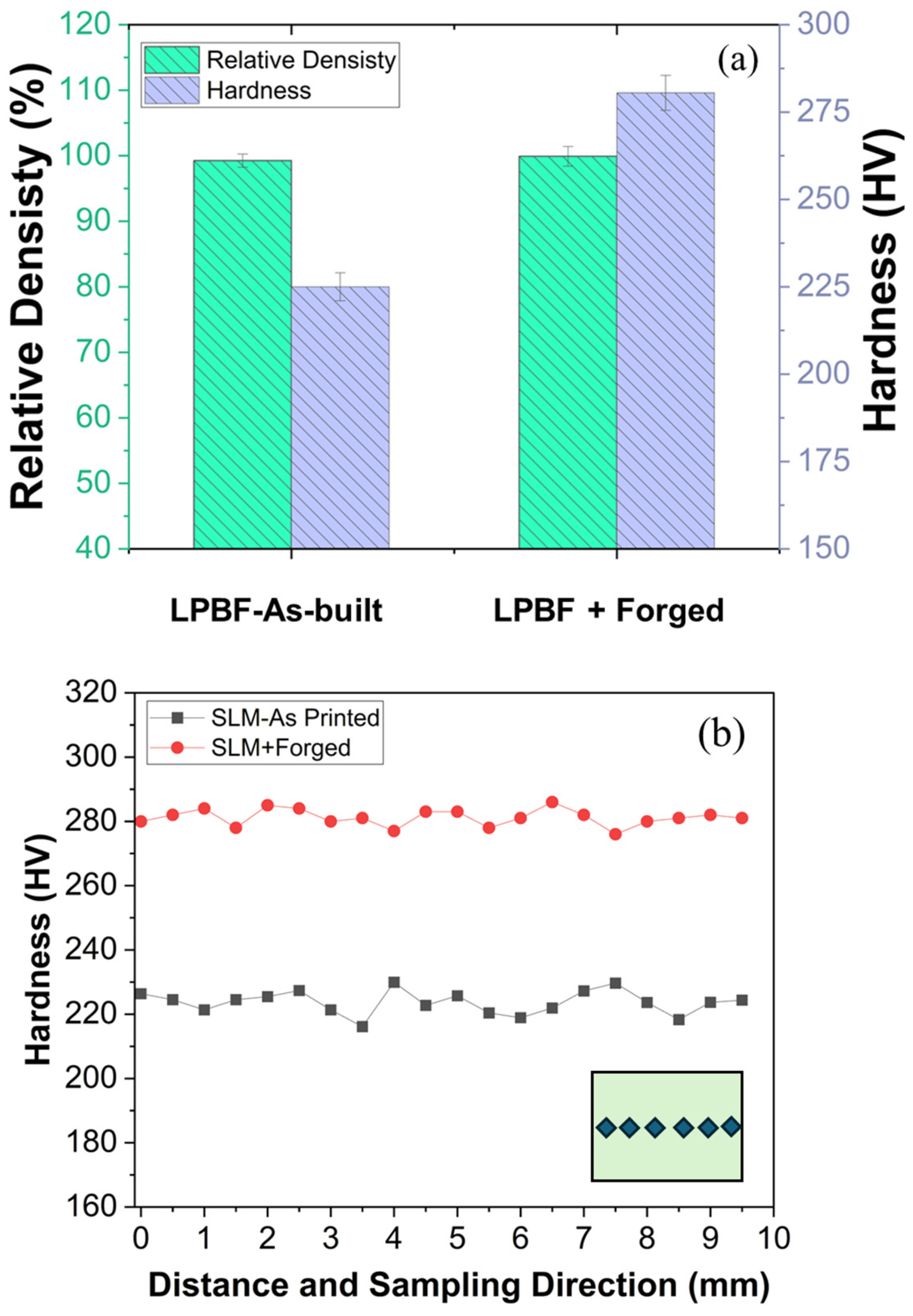
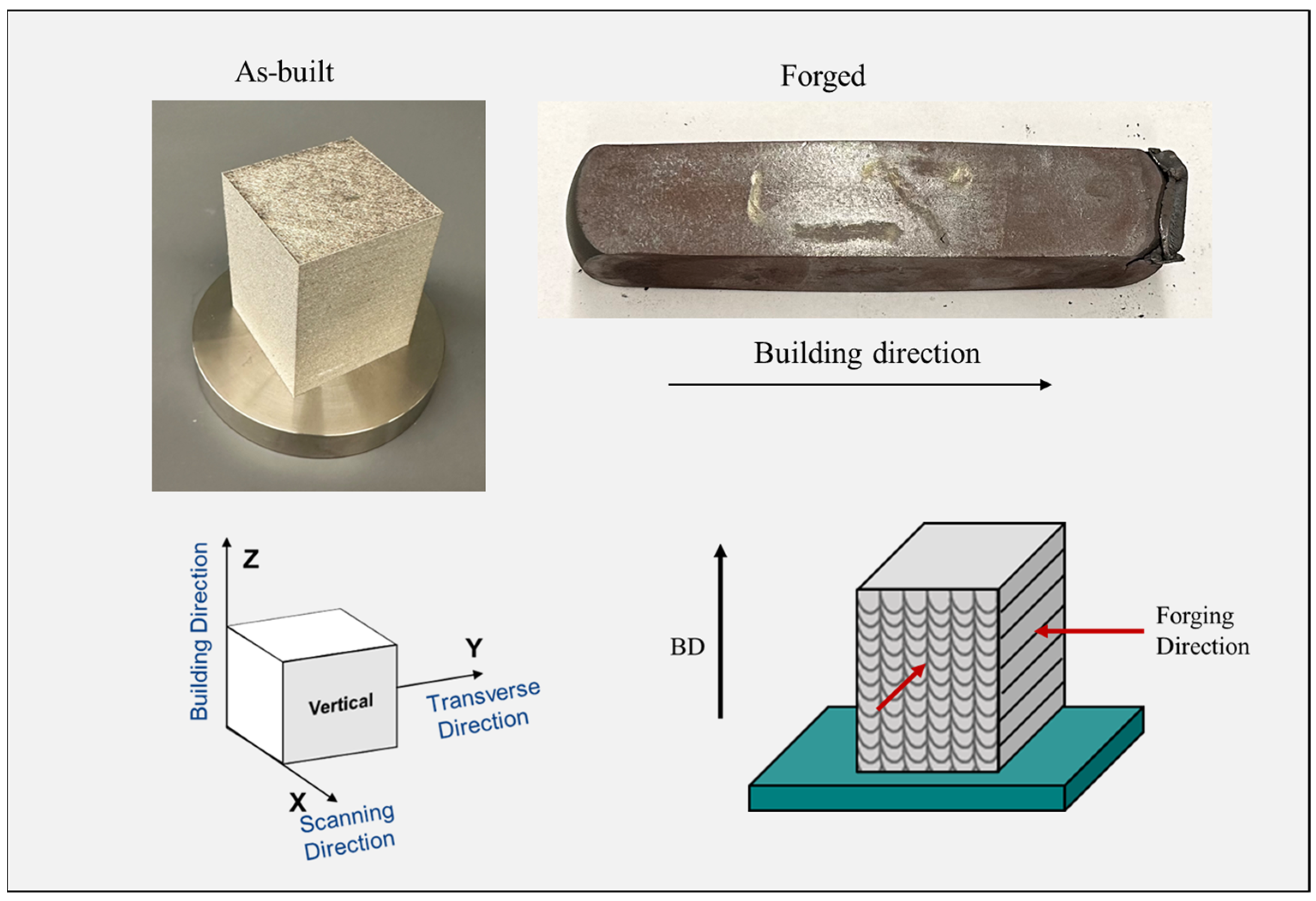


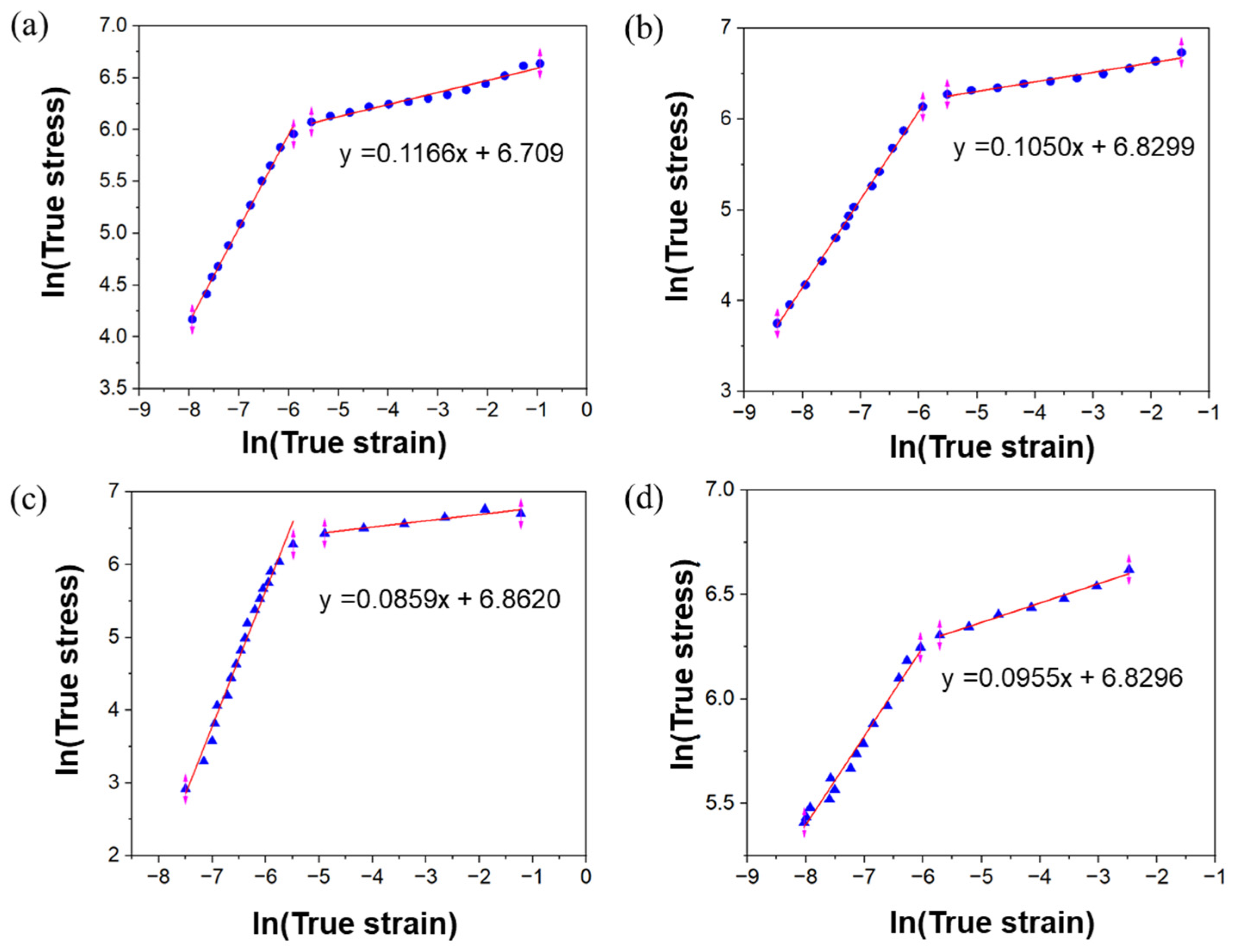
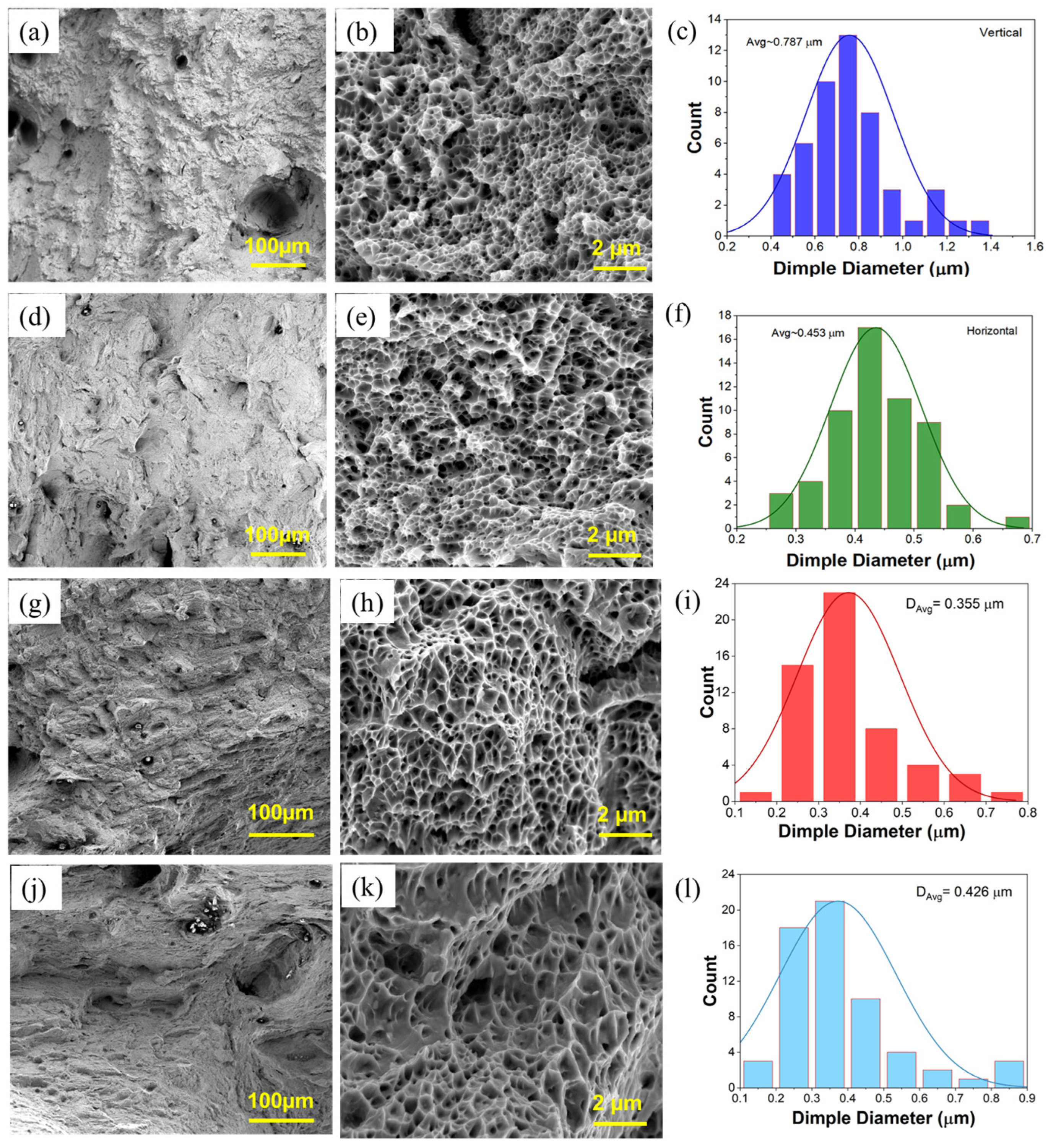
| Element | Fe | Cr | Ni | Mo | Mn | Si | N | O | P | C | S |
|---|---|---|---|---|---|---|---|---|---|---|---|
| wt.% | Balance | 16–18 | 10–14 | 2–3 | 2 | 1 | 0.1 | 0.1 | 0.045 | 0.03 | 0.03 |
| Laser Power (W) | Scanning Speed (mm/s) | Hatch Spacing (µm) | Layer Thickness (µm) | Laser Spot Size (µm) | Atmosphere |
|---|---|---|---|---|---|
| 180 | 350 | 125 | 40 | 55 | Argon |
| Specimens | Plane/Direction | Average Grain Size (µm) | Maximum Grain Size (µm) |
|---|---|---|---|
| As-built | XY-Horizontal | 35 | 43.25 |
| YZ-Vertical | 58 | 63.52 | |
| XZ-Vertical | 54 | 59.22 | |
| As forged | XY-Horizontal | 1.01 | 4.42 |
| YZ-Vertical | 2.35 | 7.20 | |
| XZ-Vertical | 3.02 | 10.37 |
| SLM | X (Length) (mm) | Y (Width) (mm) | Z (Height) (mm) | Increase in Z After Forging | True Strain ln(L/Lo) |
|---|---|---|---|---|---|
| As-built | 60 | 60 | 80 | - | - |
| Forged | 42 | 48 | 209 | 161% | 0.96 |
| Sample | YS (MPa) | UTS (MPa) | Elongation (%) | Reference |
|---|---|---|---|---|
| L-PBF-As-built (V) | 442.5 | 560 | 47 | Present work |
| L-PBF-As-built (V) | 400 | 520 | 20 | [45] |
| L-PBF + Forged (V) | 560 | 740 | 32 | Present work |
| L-PBF-As-built (H) | 550 | 677.5 | 37.5 | Present work |
| L-PBF-As-built (H) | 380 | 500 | [45] | |
| L-PBF + Forged (H) | 605 | 710 | 28 | Present work |
| L-PBF + Forged (V) | 380 | 500 | 15 | [39] |
| L-PBF + Forged (H) | 345 | 530 | 17 | [45] |
| L-PBF + Forged (V) | 351 | 540 | 18.3 | [45] |
| Wrought | 261.1 | 562.2 | 62.8 | [46] |
| Wrought-Annealed | 260 | 581 | 59.2 | [47] |
| Wrought + Forged (3 Pass) | 450 | 896 | 26 | [38] |
| Wrought + Forged (9 Pass) | 600 | 1060 | 8.0 | [38] |
| Hot Isostatic Pressing (HIP) | 331 | 656 | 43 | [48] |
| Sample | Orientation | k (MPa) | 95% CI (k) | n | 95% CI (n) | R2 | Reference |
|---|---|---|---|---|---|---|---|
| L-PBF | V | 812.40 | 780–862 | 0.1166 | 0.1166 ± 0.010 | 0.986 | Present study |
| H | 915.98 | 880–973 | 0.1050 | 0.1050 ± 0.010 | 0.995 | ||
| L-PBF+ Forging | V | 953.36 | 909–004 | 0.0859 | 0.0859 ± 0.010 | 0.989 | Present study |
| H | 915.98 | 880–972 | 0.0925 | 0.0925 ± 0.010 | 0.994 | ||
| Wrought | Td | 1178.5 | - | 0.348 | - | 0.996 | [47] |
| Rd | 1195.1 | - | 0.349 | - | 0.994 |
Disclaimer/Publisher’s Note: The statements, opinions and data contained in all publications are solely those of the individual author(s) and contributor(s) and not of MDPI and/or the editor(s). MDPI and/or the editor(s) disclaim responsibility for any injury to people or property resulting from any ideas, methods, instructions or products referred to in the content. |
© 2025 by the authors. Licensee MDPI, Basel, Switzerland. This article is an open access article distributed under the terms and conditions of the Creative Commons Attribution (CC BY) license (https://creativecommons.org/licenses/by/4.0/).
Share and Cite
Kusekar, S.; Elder, J.; Desai, J.; Ahsan, S.; Young, D.; Walunj, G.; Borkar, T. Laser Powder Bed Fusion and Hot Forging of 316L Stainless Steel: A Hybrid Additive Manufacturing Approach for Enhanced Performance. Materials 2025, 18, 4909. https://doi.org/10.3390/ma18214909
Kusekar S, Elder J, Desai J, Ahsan S, Young D, Walunj G, Borkar T. Laser Powder Bed Fusion and Hot Forging of 316L Stainless Steel: A Hybrid Additive Manufacturing Approach for Enhanced Performance. Materials. 2025; 18(21):4909. https://doi.org/10.3390/ma18214909
Chicago/Turabian StyleKusekar, Sambhaji, James Elder, Jay Desai, Showmik Ahsan, Daniel Young, Ganesh Walunj, and Tushar Borkar. 2025. "Laser Powder Bed Fusion and Hot Forging of 316L Stainless Steel: A Hybrid Additive Manufacturing Approach for Enhanced Performance" Materials 18, no. 21: 4909. https://doi.org/10.3390/ma18214909
APA StyleKusekar, S., Elder, J., Desai, J., Ahsan, S., Young, D., Walunj, G., & Borkar, T. (2025). Laser Powder Bed Fusion and Hot Forging of 316L Stainless Steel: A Hybrid Additive Manufacturing Approach for Enhanced Performance. Materials, 18(21), 4909. https://doi.org/10.3390/ma18214909










